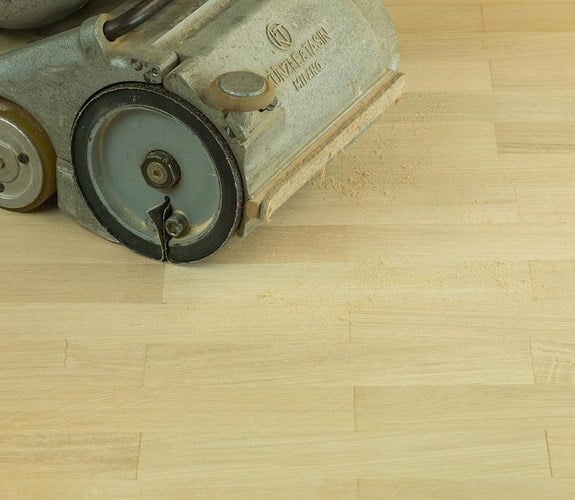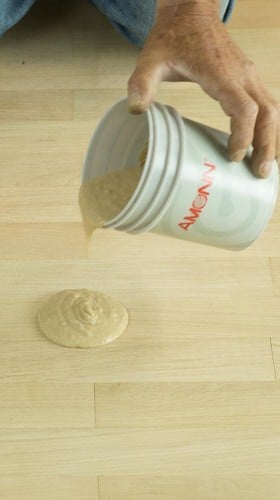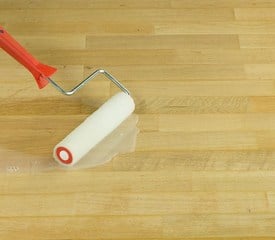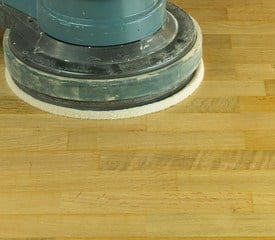
HOW DO YOU APPLY THE PRODUCTS?
PREPARING THE SURFACE AND VARNISHING




These days, unlike in the past, flooring is sold with its components already rubbed down and with optimised joints, therefore filling and rubbing down is not necessary. If however, you decide to use raw timber or you are restoring old parquet, the following steps have to be taken.
Rubbing down. For the first step (coarse rub-down) the flooring must be rubbed down using 36 – 40 grain sandpaper. When rubbing down it is important to work along the wood grain or diagonally to it to avoid leaving signs of this on the surface being treated. It is equally important to raise and lower the abrasive roller at the beginning and end of each run to avoid creating areas of different depth. These areas must be re-touched with an orbital sander of the same grain, working in the opposite direction to the original rub-down. The second step (medium rub-down) is carried out using finer grain sandpaper, usually 60 – 80. Before doing this, it is advisable to clean the surface with a vacuum cleaner. Now the last, fine rub-down is done, creating the final wood surface, using 100 – 120 grain sandpaper.
Filling. To close any gaps between the parquet strips, the sanding dust obtained while the surface is being prepared is used, mixing it with a suitable product to make a filler of the same colour as the wood. Amonn offers the products Stufex R 1500, Stufex Gel Filler and Stufex VT Filler, all of which have different features, to be teamed with the particular varnish chosen. The filler paste is spread inside the gaps and after about an hour the surface can be sanded down with 120 – 150 grain sandpaper to create a smooth, even surface.
Preparing the primer. After the wood had been rubbed down and filled, a coat of primer can be applied. Amonn offers Stufex R 1551, Stufex R 31 and Stufex R 24 primers to be teamed with the chosen varnish. The product is normally applied with a micro-fibre roller or one with medium length hair (approx. 6 – 8mm), but a paintbrush can also be used for applying the primer using cross-strokes to obtain an evenly treated surface. When using the products Stufex R 31 and Stufex R 24, once the drying time has elapsed, the surface should be sanded down, but if using Stufex R 1551 it is possible to go straight ahead with varnishing, with no need for sanding down.
Varnishing. The last stage in the process is varnishing, applying two coats of finishing varnish with paintbrush, roller or spray with an Airmix nozzle. It is also advisable to use cross-strokes when varnishing to produce a more even result. It is important to sand down the surface between the two coats of varnish, using 180 – 200 grain sandpaper. When applying varnish with a spray to a floor that is already laid, great care should be taken not to allow the dust created by nebulised varnish to settle on the floor which would create a speckled look. This is why this system is more often used on pre-finished pieces that are then fitted in situ, for example staircase treads and risers. For the best result, we recommend waiting the full drying time between the two coats and then waiting 24 hours before walking on the parts of the floor thus treated. It also advisable to wait at least 7 days before placing furniture in the room.
Some handy hints.
- If less than the necessary quantity of varnish is used, it may not spread properly and roller marks may be left. This can also happen if the temperature is too high, over 30°C, in which case you should use a retardant thinner such as Stufex thinner 019 or apply the varnish at a cooler time of day.
- If after 24 hours the varnish is still not ready for sanding down, this may be because the environment is too humid. In this situation air the room or use dehumidifiers to speed up the drying time.
- Effective sanding-down between coats creates good anchorage between the layers of varnish, thus preventing peeling.
- If the floor is covered in specks, this is normally due to sanding down residues not being removed before varnishing. Vacuum cleaning perfectly and wiping with an anti-static cloth before varnishing avoids this problem.
- Varnish creep happens when there are such contaminants such as oil or silicone on the surface being varnished. Stop work immediately and clean the under-surface thoroughly.

